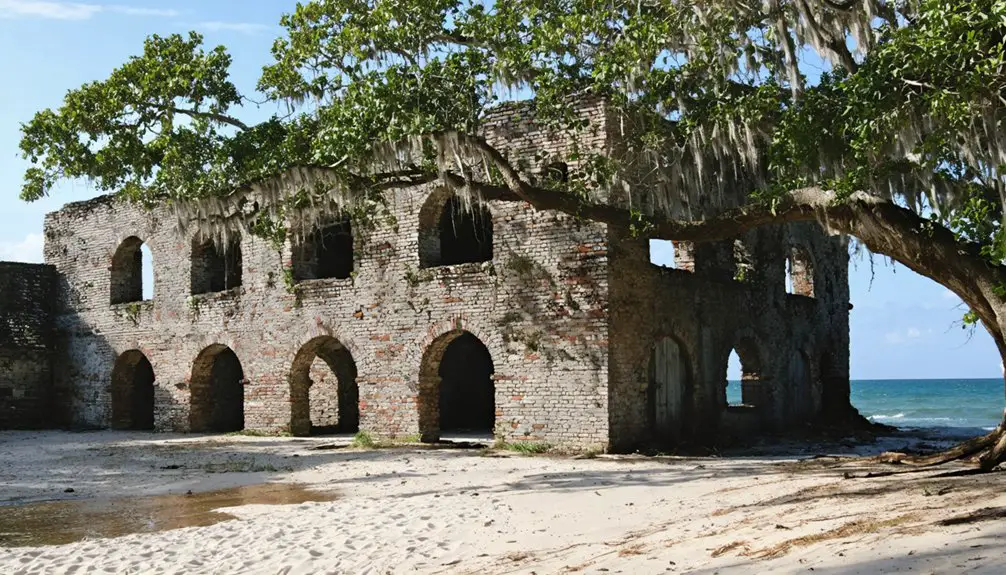You’ll find Fort Pickens as a formidable 19th-century coastal fortress on Florida’s Santa Rosa Island, not a traditional ghost town. Built in 1829 with over 21.5 million bricks, it served as a vital Union stronghold during the Civil War and later imprisoned Apache leader Geronimo. Today, the fort’s shadowy tunnels and mysterious phenomena attract visitors to its preserved grounds within Gulf Islands National Seashore, where centuries of military history and paranormal encounters await exploration.
Key Takeaways
- Fort Pickens, located on Santa Rosa Island, is an active tourist destination within Gulf Islands National Seashore, not a ghost town.
- The fort attracted over 8.2 million visitors in 2023, generating $417 million in visitor spending.
- While abandoned as a military installation, the fort remains preserved as a historical site with guided tours and camping facilities.
- Paranormal activity reports include shadowy figures in tunnels and Native American whispers, contributing to its mysterious atmosphere.
- The site maintains historical significance through preservation efforts while serving as a popular cultural and recreational destination.
The Birth of a Coastal Fortress
As tensions between European powers and the young American nation simmered in the early 19th century, the U.S. government launched an ambitious coastal defense initiative that included Fort Pickens on Santa Rosa Island.
You’ll find this massive fortification commanding the strategic approaches to Pensacola Bay, where construction began in 1829 under Colonel William H. Chase’s supervision.
The fort’s architectural innovation shines through its pentagonal design, crafted by French engineer Simon Bernard. Rising 40 feet high with walls capable of supporting 200 cannons, it required over 21.5 million bricks to complete. When completed in October 1834, the fortress marked a milestone in American military construction.
You’re looking at what was once the Gulf of Mexico’s largest brick structure, purposefully integrated into a broader coastal defense network alongside Fort Barrancas, Fort McRee, and the Pensacola Navy Yard. The fort’s western bastions included mine chambers designed specifically to thwart land invasions from the west.
This formidable fortress embodied America’s growing maritime power and determination to protect its sovereignty.
Engineering Marvel of the Gulf Coast
You’ll find Fort Pickens‘ innovative brick construction represents one of America’s most impressive Third System fortifications, featuring advanced masonry techniques designed to withstand heavy artillery bombardment.
The fort’s sophisticated defense systems incorporated mine chambers in its westernmost bastions and a strategic counterscarp on the east side, creating an impenetrable barrier against both land and sea attacks.
Its carefully engineered position at Santa Rosa Island’s western tip maximized control over Pensacola Bay while integrating seamlessly with the natural coastal landscape to enhance its defensive capabilities. The impressive structure, completed in 1834, showcased the military engineering prowess of early American fort design.
Innovative Brick Construction Methods
While many coastal fortifications of the 19th century were impressive, Fort Pickens stood out as an engineering marvel through its innovative brick construction methods.
You’ll find that the fort’s remarkable brick durability stemmed from its use of over 21.5 million bricks, making it the largest brick structure on the Gulf Coast at the time.
The masonry techniques employed were cutting-edge for the 1830s. You can see this expertise in the vaulted ceilings over the casemate tiers, which protected mounted guns through sophisticated brick and mortar work. The brick-making operation relied heavily on the clay deposits of Escambia River to produce high-quality construction materials.
The construction combined skilled craftsmen and enslaved laborers who created an intricate system of waterproofing with lead sheets, while incorporating granite steps and copper fixtures.
This blend of materials and methods resulted in a fortress that has withstood two centuries of harsh coastal conditions.
Advanced Artillery Defense Systems
Through its sophisticated artillery systems, Fort Pickens exemplified the pinnacle of 19th-century coastal defense engineering.
You’ll find an impressive array of up to 200 cannon strategically positioned across five bastions, with 112 guns concentrated along the critical shipping channel walls. The impressive 15-inch Rodman guns could launch massive 450-pound projectiles. The fort’s advanced targeting capabilities included a spotting tower for precise range-finding and innovative 12-inch disappearing rifles that could retract into 25-foot diameter pits after firing.
When Battery Pensacola was constructed in 1899, it modernized the fort’s defensive capabilities with reinforced concrete structures.
You’ll discover multiple layers of defense, from the coastal artillery batteries to underwater minefields controlled by electrical detonation systems.
The fort’s countermine chambers, each holding over 1,000 pounds of gunpowder, protected against land assaults, while WWII-era Battery 234 featured rapid-fire guns in cast steel shrouds, representing continuous technological advancement in coastal defense.
Strategic Coastal Design Elements
Fort Pickens stands as a masterpiece of 19th-century coastal engineering, strategically positioned on the western tip of Santa Rosa Island to dominate Pensacola Bay’s maritime approaches.
This coastal fortification’s pentagonal design maximizes defensive coverage with four seaward-facing walls and one landward wall, rising 40 feet high with over 21.5 million bricks.
You’ll find remarkable military architecture in the fort’s advanced defensive features, including a counterscarp moat and reversed-arch tunnels that have withstood centuries of coastal conditions.
The structure’s integration into a broader defense network allowed it to coordinate with Fort Barrancas and Fort McRee, creating an impenetrable ring of fire with positions for 200 cannons.
General Simon Bernard’s design modifications optimized the fort’s defensive capabilities while leveraging natural geographic features as protective buffers.
Construction of the fort involved skilled slave labor to complete the massive structure, which was finished in 1843.
As part of the innovative Third System fortifications, Fort Pickens enhanced and improved upon earlier American defensive structures.
Strategic Military Significance
Situated strategically at the western end of Santa Rosa Island, this massive coastal fortification played a significant role in protecting Pensacola Bay and its essential naval installations during the 19th century.
You’ll find Fort Pickens was designed as part of America’s extensive military strategy to secure crucial waterways after acquiring Florida in 1821.
The fort’s placement contributed to its vital defensive position as part of a system including Forts McRee and Barrancas.
Construction of the fort between 1829 and 1834 relied heavily on enslaved laborers working under harsh conditions.
- You’re looking at a fortress that denied enemy forces access to one of the South’s most strategic harbors.
- You’ll discover how it protected the crucial Pensacola Navy Yard from foreign threats.
- You can see how it prevented enemies from using Santa Rosa Island as a staging ground.
- You’re witnessing a cornerstone of coastal defense that safeguarded a key maritime entry point.
The fort’s placement, designed by expert military engineers, created an imposing deterrent while controlling access to both the Gulf of Mexico and Pensacola Bay.
Union Stronghold During the Civil War
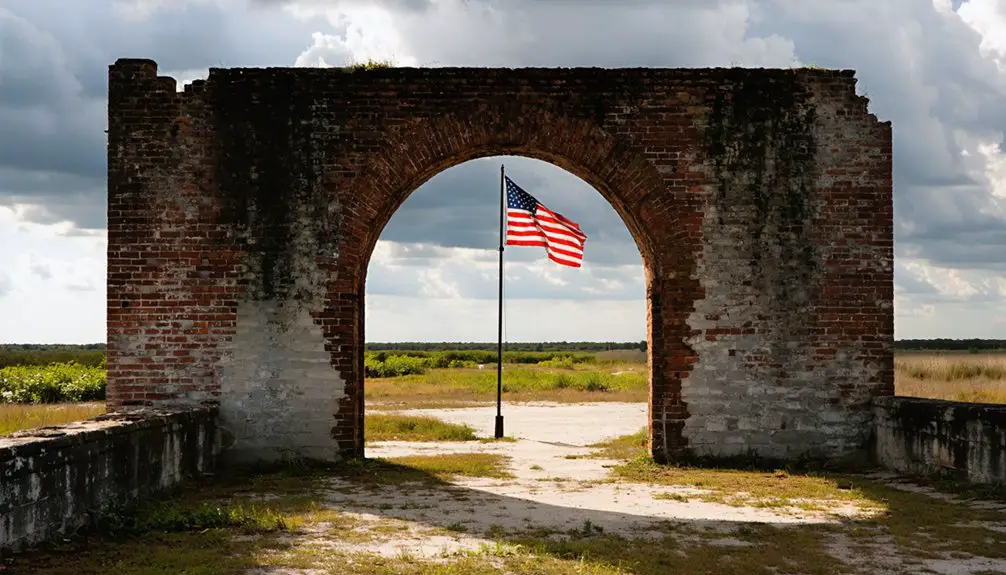
You’ll find Fort Pickens’ endurance as a Union stronghold particularly remarkable, as it remained one of only four Southern seacoast forts to stay under continuous Federal control throughout the Civil War.
Under the initial command of Lieutenant Adam J. Slemmer, the fort’s small garrison of 51 soldiers and 30 sailors successfully rejected Confederate surrender demands in January 1861, later receiving critical reinforcements that included the 6th New York Infantry Regiment.
The fort’s defenders demonstrated their resilience during the Battle of Santa Rosa Island in October 1861, when Union forces decisively repelled a nighttime surprise attack by over 1,000 Confederate troops, resulting in approximately 90 Confederate casualties.
Strategic Location and Control
Along the western tip of Santa Rosa Island, a formidable Union stronghold dominated the entrance to Pensacola Harbor throughout the Civil War.
Fort Pickens’ historical significance stems from its strategic location at this crucial maritime chokepoint, where it served as a cornerstone of coastal defenses protecting one of the South’s deepest harbors.
You’ll find these remarkable defensive advantages that kept the fort in Union hands:
- Its pentagonal design maximized artillery coverage over the bay’s mouth
- Natural barrier island positioning provided clear sight lines for enemy detection
- Advanced masonry construction withstood prolonged sieges
- Eastern moat deterred mainland assault while allowing naval resupply
This crucial position enabled Union forces to maintain control of Pensacola Bay, effectively strangling Confederate maritime operations in the region and securing a critical base for Gulf Coast operations.
Union Garrison Stands Firm
When Florida seceded from the Union in January 1861, Lieutenant Adam J. Slemmer made vital strategic decisions that would shape Fort Pickens’ destiny. With only 51 soldiers and 30 sailors, he abandoned the less defensible Fort Barrancas, consolidated his forces at Pickens, and destroyed resources that could aid the Confederacy.
Despite multiple surrender demands from Confederate forces, garrison morale remained steadfast. You’ll find that this determination paid off when President Lincoln ordered reinforcements in April 1861, bringing Colonel Harvey Brown to assume command.
The 6th New York Infantry’s arrival in June further strengthened the Union’s position. This resolve was tested during the October 9th Confederate assault on Santa Rosa Island, but the garrison’s coordinated defense resulted in a decisive victory, cementing Fort Pickens’ status as an enduring Union stronghold in Confederate territory.
Repelling Confederate Forces
Under cover of darkness on October 9, 1861, Confederate Brigadier General Richard Anderson launched a bold assault against Fort Pickens, leading 1,000-1,200 troops in a surprise landing four miles east of the Union stronghold.
Confederate tactics initially succeeded in routing the 6th New York Volunteers at Camp Brown, but disorientation among sand dunes hindered their advance.
- Union forces countered fiercely, driving Confederates back in a running skirmish
- Fort Pickens’ artillery and gunboat threats forced the enemy to retreat
- The assault cost Anderson’s forces 87 casualties compared to 67 Union losses
- Union resilience prevailed as Confederate forces abandoned their objective
The failed attack exemplified Fort Pickens’ strategic significance as one of only four Southern forts remaining in Union control throughout the Civil War, despite repeated Confederate attempts to seize this crucial stronghold.
The Battle of Santa Rosa Island
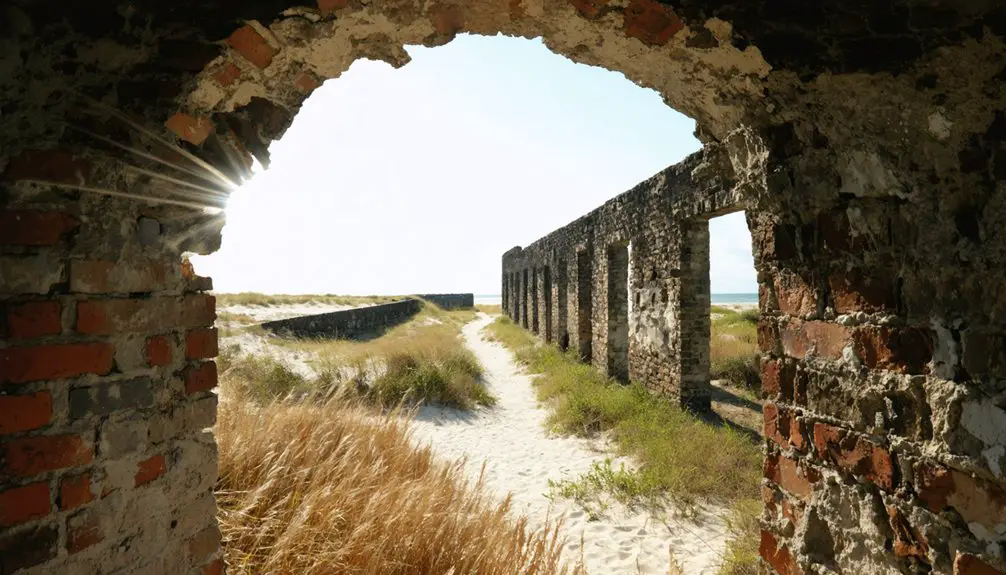
The Battle of Santa Rosa Island erupted on October 9, 1861, as Brigadier General Richard Anderson led 1,200 Confederate troops in a daring nighttime raid against Union positions. The Confederate tactics involved landing four miles east of Fort Pickens and dividing into three columns before launching a surprise attack on Camp Brown, successfully routing the 6th New York Regiment.
You’ll find that despite this initial victory, the tide turned when Union reinforcements arrived. Colonel Harvey Brown dispatched companies under Major Vogdes and Major Arnold, while artillery support from Fort Pickens forced the Confederates to withdraw.
The battle’s toll included 14 Union soldiers killed and roughly 30-40 Confederate casualties, including Anderson’s severe elbow wound. Though the Confederates destroyed Camp Brown, they failed to capture Fort Pickens, resulting in a Union tactical victory.
Native American Connections and Geronimo’s Legacy
When you visit Fort Pickens today, you’re walking the same grounds where Apache leader Geronimo and fifteen other warriors were imprisoned from 1886 to 1887, performing hard labor under military guard.
You’ll find that while imprisoned here, Geronimo became a tourist attraction, with thousands paying admission fees to see the famous war chief in captivity.
The fort’s role as a prison for Native American leaders exemplifies the U.S. government’s strategy of forcibly relocating indigenous people far from their ancestral lands, leading to profound cultural and familial disruptions that still resonate in Apache communities today.
Geronimo’s Prison Life
Following his capture in 1886, legendary Apache leader Geronimo endured harsh imprisonment at Fort Pickens in Florida, where he and 15 other Apache men faced separation from their families, who were sent to Fort Marion in St. Augustine.
The U.S. government’s response to Geronimo’s resistance resulted in strict confinement under President Cleveland’s orders, without trial.
- You’ll find traces of their forced labor – cleared weeds, planted grass, and stacked cannonballs still visible at the fort.
- The Apache prisoners battled unfamiliar diseases, with tuberculosis claiming many lives during their captivity.
- Tourists paid admission to gawk at the imprisoned warrior, reducing him to a mere attraction.
- Their families weren’t reunited until 1887, enduring a full year of separation that violated previous promises to the Apache people.
Sacred Apache Connections
Deep within Fort Pickens’ history lies a complex story of disrupted Native American spirituality, where Geronimo and his fellow Apache prisoners faced not just physical confinement but profound cultural displacement.
You’ll find that Apache spirituality suffered greatly during their imprisonment, as the coastal environment contrasted sharply with their sacred ancestral lands. While confined at Fort Pickens, these spiritual leaders were cut off from traditional practices and family connections central to their cultural identity.
Yet, you can witness remarkable cultural resilience in how Geronimo maintained his role as a medicine man and spiritual guide despite these challenging circumstances.
Today, his legacy resonates as a powerful symbol of Native American resistance and survival, reminding us how Apache spiritual traditions endured even through forced relocation and military captivity.
Unexplained Phenomena and Haunted Tales
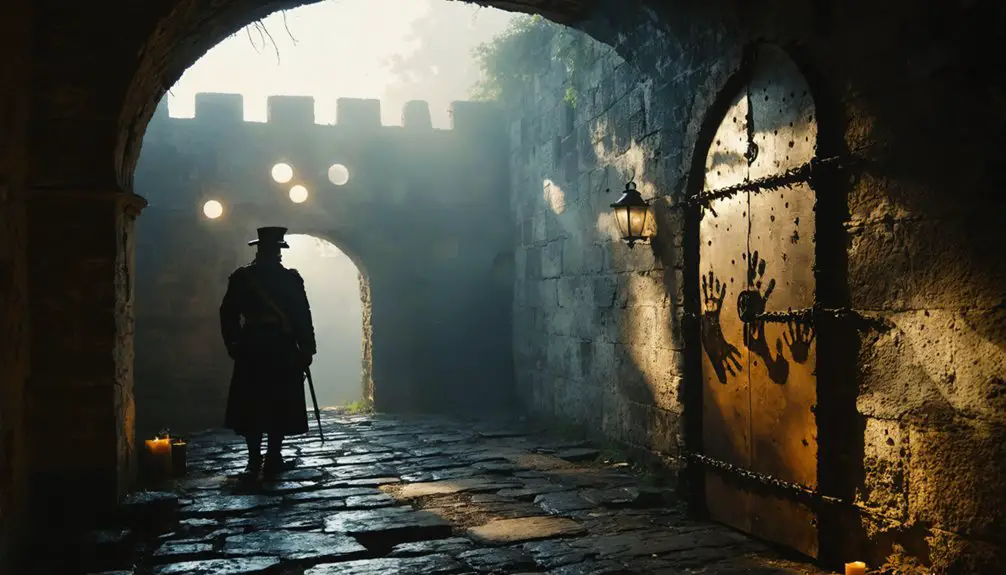
How does a 19th-century military fortress transform into one of Florida’s most notorious paranormal hotspots? At Fort Pickens, you’ll encounter a complex tapestry of unexplained sightings and ghostly whispers that defy rational explanation.
The fort’s dark corridors and battle-scarred walls hold centuries of military conflict, spiritual unrest, and Apache Chief Geronimo’s legendary curse.
- Cold spots materialize without warning, while electronic devices capture mysterious voices
- Civil War soldiers’ apparitions patrol the battlements, their footsteps echoing through empty passages
- Phantom cannon fire and battle sounds pierce the night, especially during storms
- Shadowy figures dart through tunnels, accompanied by inexplicable whispers in Native American tongues
Scientific investigators continue documenting these phenomena, adding credibility to Fort Pickens’ reputation as a paranormal epicenter where past and present collide in mysterious ways.
Natural Disasters and Structural Challenges
While Fort Pickens has endured nearly two centuries as a coastal sentinel, its location on Santa Rosa Island exposes it to nature’s most destructive forces.
You’ll find evidence of natural disasters throughout its history, from Hurricane Ivan‘s devastating impact in 2004 to Hurricane Dennis’s 145 mph assault in 2005. These storms destroyed miles of road and buried structures under meters of sand.
The fort faces constant structural challenges from its harsh coastal environment. Salt air corrodes metal fixtures, while storm surge and shifting dunes threaten the foundation’s stability.
Even the fort’s impressive brick masonry and reversed-arch tunnels, originally designed to withstand artillery fire, now battle against coastal erosion and rising sea levels.
The 1989 tornado that destroyed the entrance station serves as a stark reminder of the site’s vulnerability to nature’s fury.
Historical Preservation Efforts
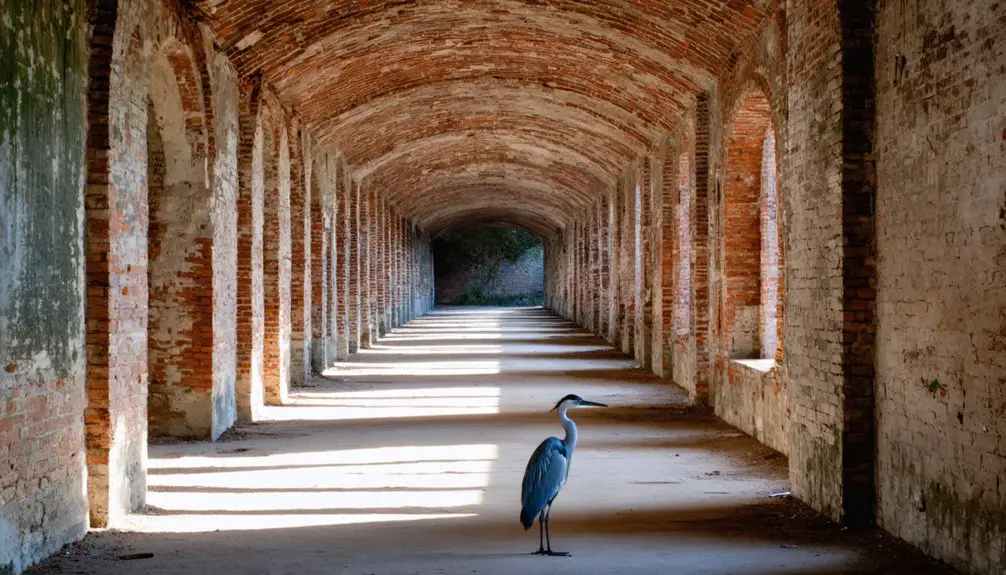
To combat nature’s relentless assault on Fort Pickens, the National Park Service implements extensive preservation strategies as part of the Gulf Islands National Seashore management. Their historic preservation efforts focus on maintaining the fort’s original architectural features while ensuring public access to this remarkable piece of American history.
- You’ll witness meticulous conservation techniques, including brick cleaning and repointing of mortar joints, protecting the structure’s integrity.
- You’re experiencing the careful balance of authentic restoration and modern safety requirements.
- You can explore the preserved pentagonal design featuring over 21.5 million original bricks.
- You’ll find educational programs that connect you directly with preservation activities.
The National Park Service collaborates with local organizations to maintain this architectural marvel, implementing research-based restoration methods that honor the fort’s historical significance while protecting its future.
Modern-Day Tourism and Cultural Impact
Since becoming part of the Gulf Islands National Seashore, Fort Pickens has emerged as a major economic driver for Florida’s Gulf Coast region, attracting over 8.2 million visitors in 2023 alone.
You’ll find cultural tourism thriving here, with self-guided tours through preserved military structures and interpretive programs that bring the fort’s rich history to life. The economic impact is substantial – visitor spending reached $417 million in 2023, supporting over 5,300 local jobs and generating $542 million in cumulative benefits.
You can explore hiking trails, including the Florida Scenic National Trail’s northern terminus, enjoy protected beaches for fishing and wading, or camp nearby. The fort’s integration with the National Seashore creates a thorough experience where history meets natural beauty.
Frequently Asked Questions
What Was the Daily Life Like for Soldiers Stationed at Fort Pickens?
You’d spend your days conducting soldier routines like mounting cannons and daily drills, while living among 60-1,000 fellow troops inside the fort’s 40-foot-high brick walls under varying conditions.
How Many Bricks From the Original Construction Still Remain in Place Today?
Through mountains of historical preservation efforts, you’ll find nearly all of the original construction’s 21.5 million bricks still standing today, with experts estimating over 90% remain firmly in place.
What Other Famous Prisoners Besides Geronimo Were Held at Fort Pickens?
You’ll find Geronimo’s band of 16 Apache warriors were the most historically significant prisoners, with no other famous captives documented. Civil War Confederate prisoners were held there, but their prisoner stories remain unnamed.
Were There Any Underground Tunnels or Secret Passages Within Fort Pickens?
You’d be amazed by Fort Pickens’ extensive tunnel network – including secret entrances and hidden chambers used for storing ammunition, moving troops, and even a self-destruction tunnel designed to implode the fort if invaded.
What Happened to the Fort’s Original Artillery and Military Equipment?
You’ll find most original artillery was removed or scrapped during Endicott-era upgrades, though some pieces, like the 15-inch Rodman gun, remain preserved for military history education and display purposes.
References
- https://uwfvoyager.com/3720/opinion/the-hauntings-and-folklores-of-northwest-florida/
- https://en.wikipedia.org/wiki/Fort_Pickens
- https://nostoneunturnedadventures.com/2019/03/28/fort-pickens-and-pensacola-florida-a-photographers-dream/
- https://www.nps.gov/guis/learn/historyculture/fort-pickens.htm
- https://www.nps.gov/articles/fort-pickens-and-the-outbreak-of-the-civil-war-teaching-with-historic-places.htm
- https://visitpensacolabeach.com/experience-the-history-of-fort-pickens-blog/
- https://www.saj.usace.army.mil/FortPickens/
- https://www.youtube.com/watch?v=_aqVpr7fBp0
- https://www.bunnellcity.us/sites/g/files/vyhlif361/f/uploads/reduced_city_of_bunnell_construction_details_book_-_march_2022_1.pdf
- https://myescambia.com/docs/default-source/documents/engineering/construction-management/escambia-county-technical-specifications_07-01-2020.pdf
